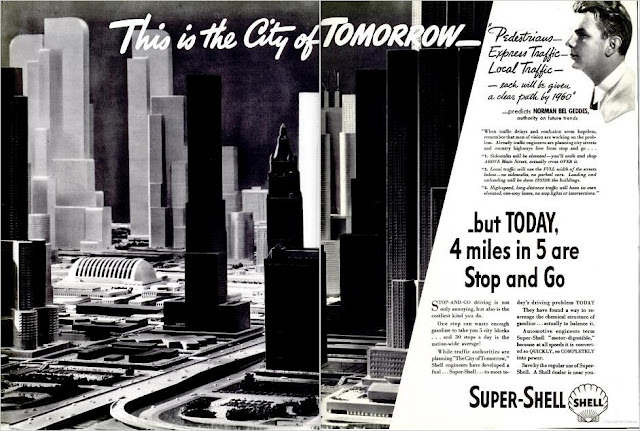
Image Credit: a456
I’ve been thinking a lot about future cities these days, though I’ve mostly been focusing on real-world metropolises as futuristic settings in TV shows and movies. Today, I’m going to shift gears to describe an idea for a future city from the past, Norman Bel Geddes’s “City of Tomorrow” advertising campaign for Shell Oil from the late 1930s. The campaign predicts (critics might say “encouraged” or “enabled”) a car-centric, highway-laden, city whose residents “loaf along at 50 [m.p.h]—right through town.” Bel Geddes’ “tomorrow” continues to resound today.
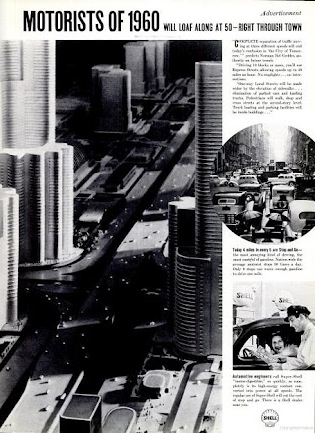 Image Credit: a456
Image Credit: a456
There’s a common theme in yesterday’s future city and today’s—the car. When last I spoke about possible future cities, I critically assessed artist Chris Burden’s “Metropolis II”, an installation where toy cars zipped across a future Los Angeles surrounded by huge strips of freeways. Bel Geddes’s “City of Tomorrow” is eerily similar to the future city Burden envisions. Both futures see unimpeded cars as the epitome of modern efficiency. And both images of the future are utterly devoid of people. Bel Geddes explains this lack by telling the readers of Life Magazine (where the “City of Tomorrow” ad campaign ran for months) that “tomorrow’s children won’t play in the streets.”
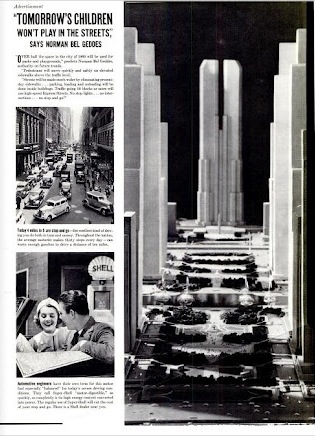
Image Credit: a456
Despite these similarities, there is a difference between Burden’s art installation and Bel Geddes’s advertising campaign, and this crucial difference is one of context. Burden created his art installation for public viewing at the LA County Museum of Art (LACMA). Burden’s dealer Larry Gagosian footed the bill for Burden’s project, while LACMA board member Nicholas Bergguren later bought the project. The key point is that the stakeholders in the project’s success are art dealers and museum board members.
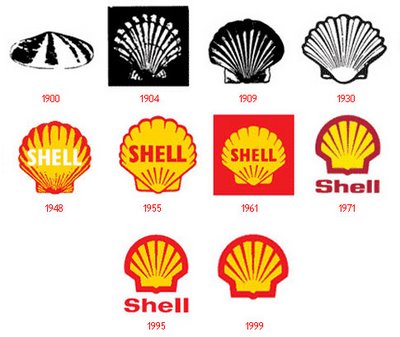
Image Credit: Best Ad
The stakeholders for Bel Geddes’s project’s success are a lot less innocuous. Shell Oil, one of the biggest petroleum distributors in the world, hired Bel Geddes for their massive, multi-segment advertising campaign. Looking at the elaborate advertisements, it’s obvious that Shell is using Bel Geddes’s designs to sell a future lifestyle that would make them millions (billions by today’s standards) if Americans decided to make it a reality. A transportation system dependent on cars would guarantee that gasoline would be a necessary commodity in the future. And it is exactly this gas-fueled future that was embraced wholeheartedly by the city planners of America in the decades following Shell’s campaign. Campaigns like Shell Oil’s “City of Tomorrow” lulled viewers into equating automobiles with ingenuity, modernity, and efficiency. Urban planners like Robert Moses and architects like Frank Lloyd Wright only realized what these viewers wanted to see: more roads, more highways, less impediments. Yet without artists and modelers like Bel Geddes to visualize a future of cars and people-less thoroughfares, what we have ended up seeing years down the line could have been a lot different.
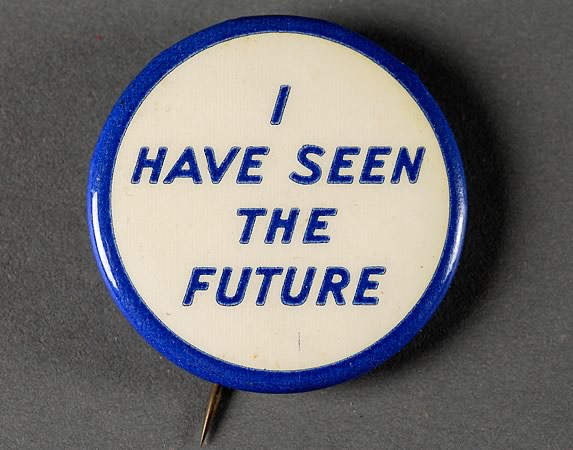
Image Credit: The Harry Ransom Center
If the “City of Tomorrow” has piqued your interest, be sure to check out the Harry Ransom Center in the fall when their “I Have Seen the Future: Norman Bel Geddes Designs America” exhibition is up and running. Until then, visit the Ransom Center’s preview page for images and background related to the upcoming exhibition.

 Image Credit:
Image Credit: 


Recent comments
2 years 29 weeks ago
2 years 44 weeks ago
2 years 44 weeks ago
2 years 50 weeks ago
3 years 4 weeks ago
3 years 4 weeks ago
3 years 4 weeks ago
3 years 6 weeks ago
3 years 6 weeks ago
3 years 6 weeks ago